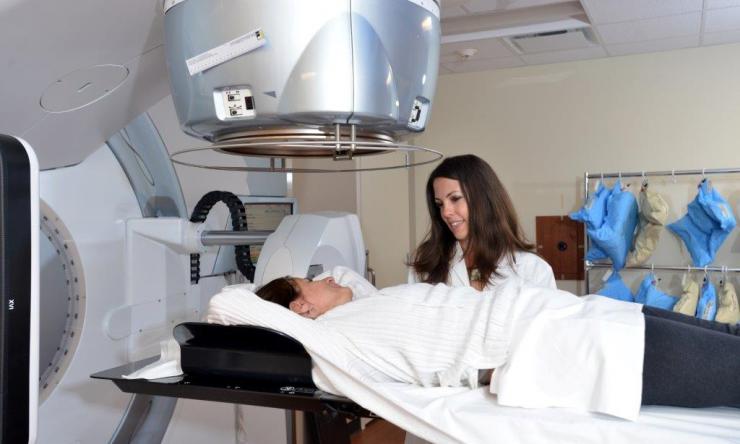About Baylor Radiation Oncology
More than half of all cancer patients receive radiation therapy at some time during their illness. Baylor Medicine radiation oncology specialists personalize treatment plans to match the needs of every patient.
As a high-volume center, Baylor Radiation Oncology in Houston, Texas, routinely performs procedures that may be done only occasionally at other locations. Studies have shown that centers performing higher volumes of procedures have better patient outcomes.
What Is Radiation Therapy?
Radiation therapy is the treatment of cancer and other diseases with ionizing radiation. Ionizing radiation deposits energy that injures or destroys cells in the area being treated (the "target tissue") by damaging their genetic material and making it impossible for these cells to continue to grow. Although radiation damages both cancer cells and normal cells, the normal cells are able to repair themselves and function properly.
What to Expect
Once you have been referred to radiation therapy you will meet with the radiation oncologist to discuss your simulation appointment, treatment plans and potential side effects.
- Bring all recent imaging results, current medications, and any insurance information.
- If available, please bring with you a family member or designated caregiver.
- Allow for one to two hours for total visit time.
If radiation has been deemed a treatment option you will be given a subsequent appointment for radiation simulation.
- It is very important to clarify with radiation staff if a certain diet is needed prior to the radiation simulation.
- If you have issues with anxiety in close spaces or with previous imaging, please inform your treating physician in advance so that actions may be taken to ensure you do not experience these during CT simulation.
Simulation
The simulation procedure will be the first step of radiation therapy. You should expect this appointment to last two hours.
During this procedure, the radiation therapist will place you in treatment position and obtain CT images of the treatment area. The therapists will place a small mark on your skin to mark the designated alignment position. This tattoo will be the size of a freckle. Additional marks will be placed on your skin to allow for reproduction of treatment position. Do not wash off these marks. Should you lose them, please notify your treatment team.
Upon completion of CT simulation, you will be given an appointment to start your radiation treatment approximately three days after your simulation. Your radiation therapist will schedule your appointments.
Treatments
Your daily treatments will take approximately 15-30 minutes depending on the complexity of treatment. Treatment days are, Monday through Friday. The radiation oncologist will also meet with you once weekly. Please plan to spend additional time for this visit. It is important to bring all medications to weekly appointments. Also, if available, please bring friend, family member, or designated caregiver.
Precautions During Treatment
Diet and Exercise
- Get plenty of rest. Treatments may cause you to be tired after a few weeks.
- An alternate to rest can include a brisk walk of 15-20 minutes which can help reduce fatigue as well.
- Maintain a balanced diet. Avoid weight loss diets during your treatment. If applicable, please avoid foods heavy in spice, fried foods, or foods with sharp edges.
Hygiene
- Do not remove the marks placed on your skin. Showers are recommended for daily hygiene. Allow water to run over the marks. Avoid using soap in the area. Pat the area dry. Soaps with alcohol are NOT recommended. Fragrance free Dove or Tone are safe.
- The marks may rub off on clothing, therefore old undergarments or t-shirts are suggested to avoid staining newer clothing.
- Avoid swimming, Jacuzzi and any activity that will cause you to perspire, which will cause the marks to fade.
- Deodorant may be used.
- Do not shave with razor the treated area.. This can cause skin irritation. If needed please use electric razor. **TALK TO YOUR DOCTOR ABOUT SHAVING BEARD OR CUTTING HAIR PRIOR TO ANY ADJUSTMENT AS THIS MAY RESULT IN COMPLICATIONS WITH RADIATION TREATMENT.
Other Precautions
- If designated area includes region of interest you doctor may ask you to have oral cleansing solution or perhaps designated bathes during treatment. Please confirm with your treating physician or nurse about required upkeep.
- Protect the treatment area from sun exposure during treatment.
- Inform your radiation oncologist of all medications you are taking.
- Inform your radiation oncologist if you experience a sore throat, as part of the esophagus may be in the treatment field.
For More Information
Types of Radiation Therapy
3D Conformal Treatment Planning and Delivery. Three-dimensional conformal radiation therapy (3D-CRT) is an emerging technology in radiation therapy that involves multimodality imaging techniques, accurate radiation dose calculation methods, computer optimized treatment planning, and computer-controlled treatment delivery.
Intensity Modulated Radiation Therapy. This advanced type of radiotherapy uses a computer-controlled device, called a linear accelerator, to deliver precise doses of radiation to tumors or specific areas within the tumors.
Image-Guided Radiation Therapy. IGRT uses frequent imaging during a course of radiation therapy to improve the precision and accuracy of the delivery the radiation treatment.
Stereotactic Radiosurgery. This form of radiation therapy focuses on high-power energy on a small area of the body. Despite its name, radiosurgery is a treatment, not a surgical procedure. Incisions (cuts) are not made on your body. Our doctors use one of the best and most advanced radiosurgery systems available, the CyberKnife. The CyberKnife at Baylor St. Luke’s Medical Center is one of only two such systems in South Texas.
Radioimmunotherapy. Radioimmunotherapy is mainly used to treat lymphoma and lymphocytic leukemia. It combines a radioactive substance with a monoclonal antibody that's injected (infused) in your body. The monoclonal antibody targets, and sometimes reacts with, proteins on cancer cells called antigens. The radioactive molecule destroys the cells.
Total Body Irradiation. Total body irradiation as used in stem-cell transplantation involves irradiation of the entire body.
High-Dose Rate and Low-Dose Rate Brachytherapy. Brachytherapy is an internal therapy in which the radiation source is placed inside the body.
Meet Our Team
Our radiation therapy team has years of special training and experience working with the equipment that delivers radiation therapy.
For Radiation Oncology Patients
Radiation oncology patient information as well as general patient forms and information including insurance, pay online, billing, hotel/motel guide, customer service, privacy practices (HIPAA) and more.
Radiation Oncology Procedures
The Department of Radiation Oncology at Baylor College of Medicine offers today's latest technology and treatment options, all of which are delivered by doctors who are leaders in their field. This means patients have early access to the latest research and clinical advances. Learn more.
Locations
Harris Health System Smith Clinic
2525-A Holly Hall St., 1st Floor
Houston, TX 77054
Appointments: (713) 566-3600
Map to Smith Clinic
O'Quinn Medical Tower at McNair
1919 Old Spanish Trail, 1st Floor
Houston, TX 77054
Appointments: (832) 957–6500
Map to O'Quinn Tower











